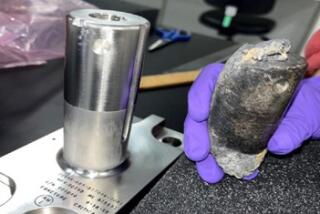Space station dodges 5-inch bullet; crew was ready to flee
- Share via
As a dangerous chunk of debris bore down on the International Space Station on Thursday, the crew took refuge in the Russian Soyuz lifeboat in case they had to flee to Earth.
NASA said a 5-inch piece of a spent rocket motor came within striking distance of the $100-billion station. If it had hit the station, damage could have been catastrophic.
Station Cmdr. Mike Fincke, Russian flight engineer Yury Lonchakov and NASA’s Sandra Magnus entered Soyuz and waited. Meanwhile, on the ground, experts fretted.
“We were watching it with bated breath,” NASA space debris scientist Mark Matney said. “We didn’t know what was going to happen.”
The debris missed. Engineers don’t know by how much and may never know, the Associated Press reported. It could have been a few hundred feet or a couple of miles.
In space, Fincke said they watched out the Soyuz window.
“We didn’t see anything, of course. We were wondering how close we were,” he said.
Matney, who has been with NASA since 1992, said it was the closest call he could remember.
Ten minutes later, with the danger over, the crew returned to the space station.
Soyuz has been used for shelter at least five times in the past, NASA spokesman Josh Byerly said. And the crew may have to use it again soon because this orbiting hazard could return, the Orlando Sentinel reported.
“It’s still crossing the station orbit, so there’s a probability that it could threaten the station in the future,” said Gene Stansbery, program manager for NASA’s orbital debris office in Houston.
NASA officials said that the piece of space junk came from an upper-stage rocket that helped launch a U.S. military global positioning satellite in 1993. They described it as a “portion of a spent satellite motor.”
Stansbery added that NASA had so little warning that the space junk was approaching because it moves in an unusual orbit, ranging from 89 miles above Earth to almost 2,500 miles. Each time it whips through the fringes of Earth’s atmosphere, it slows somewhat, making it hard to track.
Orbital debris has become a major problem for space-faring nations. Scientists estimate that there are tens of millions of pieces in orbit, including more than 17,000 bigger than a grapefruit. Most, though, are far higher than the space station, which orbits about 220 miles above Earth.
The congestion increased last month when two satellites, one Russian and the other American, collided nearly 500 miles above Siberia, creating one of the worst debris fields in space history.
The trash is even worse in the orbit of the Hubble Space Telescope. NASA is still calculating whether it’s safe for a shuttle crew to repair Hubble this year.
Smaller space debris often falls into lower orbit and eventually burns up as it returns to Earth.
But David Wright, a physicist with the Union of Concerned Scientists, said, “Some of the big things will be up there for centuries, and those are the ones that can really wreak havoc.”
More to Read
Sign up for Essential California
The most important California stories and recommendations in your inbox every morning.
You may occasionally receive promotional content from the Los Angeles Times.










